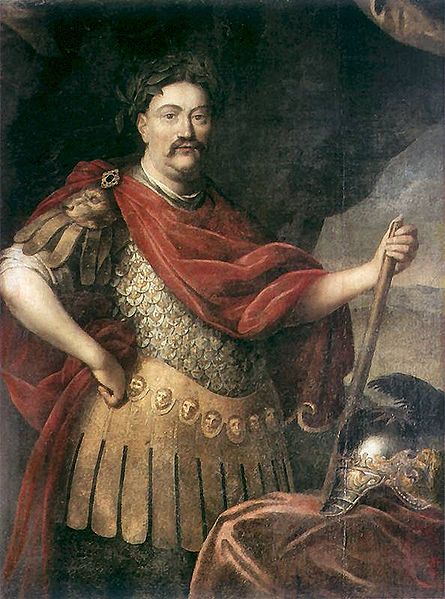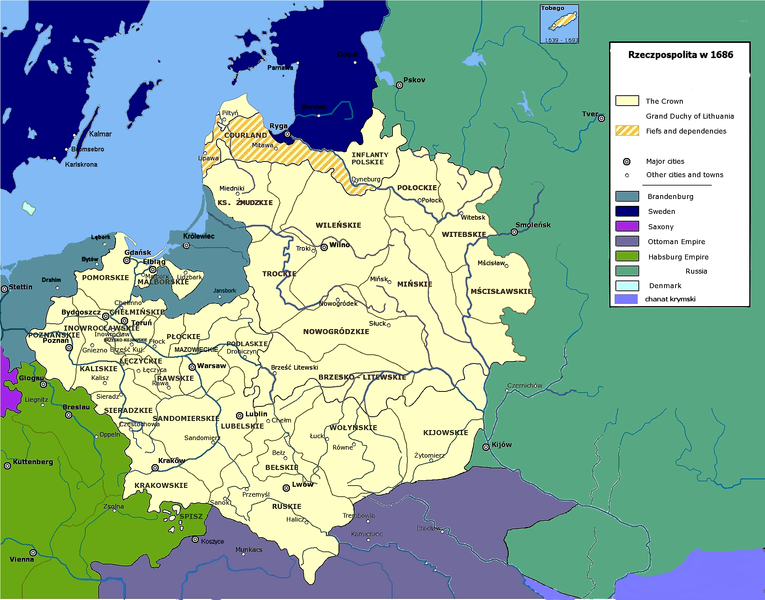<Back to Index>
- Physician Frederick Fuller Russell, 1870
- Film Producer Samuel Goldwyn, 1879
- King of Poland John III Sobiesky, 1629
PAGE SPONSOR


John III Sobieski (Polish: Jan III Sobieski) (17 August 1629 – 17 June 1696) was one of the most notable monarchs of the Polish - Lithuanian Commonwealth, from 1674 until his death King of Poland and Grand Duke of Lithuania. Sobieski's 22 year reign was marked by a period of the Commonwealth's stabilisation, much needed after the turmoil of the Deluge and Khmelnytsky Uprising. Popular among his subjects, he was also a military genius, most famous for the victory over the Turks in the 1683 Battle of Vienna. Following his victories over the Ottoman Empire, he was called by the Turks the "Lion of Lechistan" and held as the saviour of European Christendom by the pope.
John Sobieski was born 1629 in Olesko, a small town near Lwów in Poland (now Lviv, Ukraine) to a notable noble family de Sobieszyn Sobieski of Clan Janina. His father, Jakub Sobieski, was the Palatine of Ruthenia and Castellan of Kraków; his mother, Zofia Teofillia Daniłowicz was a granddaughter of Hetman Stanisław Żółkiewski. After graduating from the Nowodworski College in Kraków, young John Sobieski then graduated from the philosophical faculty of the Jagiellonian University. After finishing his studies, together with his brother Marek Sobieski, John left for western Europe, where he spent more than two years travelling. During that time he met major political figures: Louis II de Bourbon, Charles II of England and William II, Prince of Orange, and learnt French, German and Italian, in addition to Latin. This proved to be vital during his later military career.
Both brothers returned to Poland in 1648 and volunteered for the army during the Khmelnytsky Uprising. Jan founded his own banner of cavalry and commanded it in the rank of Rotamaster. After the Battle of Zboriv, the brothers were separated and Marek died in Tatar captivity the following year. Jan was promoted to the rank of pułkownik and fought with distinction in the Battle of Berestechko. A promising commander, John was sent by King John II Casimir to Istanbul in the Ottoman Empire as an envoy. There, Sobieski learnt the Tatar language and studied Turkish military traditions and tactics.
After the start of the Swedish invasion of Poland known as "The Deluge", John Sobieski was among the Greater Polish regiments led by Krzysztof Opaliński, Palatine of Poznań, which capitulated at Ujście, and swore allegiance to King Charles X Gustav of Sweden. However,
in less than a year he returned with his unit to the Polish side, and
after April 1656, he again fought for the Polish king. During the three-day long battle of Warsaw of 1656, Sobieski's command of a 2,000 man strong regiment of Tatar cavalry earnt him promotion to the title of Lord Standard-Bearer of the Crown. A strong supporter of the French faction, Sobieski remained loyal to the King during the infamous Lubomirski Rebellion, which further helped his military career. In 1665 he married Marie Casimire Louise de la Grange d'Arquien and was promoted to the rank of Grand Marshal of the Crown, and the following year, to the rank of Field Hetman of the Crown. In 1667 he achieved another great victory over the Cossacks and their Tatar allies in the Battle of Podhajce during the Polish-Cossack-Tatar War (1666 - 1671). On
5 February 1668, by now a famed and esteemed commander, he achieved the
rank of Grand Hetman of the Crown, the highest military rank in the
Polish - Lithuanian Commonwealth, and thereby the de facto commander-in-chief of the entire Polish Army. On 11 November 1673, during the Polish - Ottoman War (1672 - 1676), Sobieski added yet another major victory to his list, this time defeating the Turks in the battle of Chocim and capturing the fortress located there. The news of the battle coincided with the news of the death of Michael I, King of Poland, who had died the day before the battle. This
made Sobieski one of the most leading figures in the state, and on 19
May the following year, he was elected as monarch of the Commonwealth. His
candidacy was almost universally supported, with only a dozen or so
members of the diet opposing him. Among the most notable backers of his
candidacy was his wife. Jan Sobieski was crowned Jan III 2 February
1676.
Although
Poland-Lithuania was at that time the largest and one of the most
populous states of Europe, Sobieski became a king of a country
devastated by almost half a century of constant war. The treasury was
almost empty and the court had little to offer the powerful magnates, who often allied themselves with foreign courts rather than the state.
Sobieski decided to stabilise the situation by forcing the Ottomans to
accept a peace treaty to end the constant wars on the southern border.
In the autumn of 1674 he recommenced the war against the Turks and
managed to recapture the fortresses of Kamieniec Podolski, Bar and Reszków, which re-established a strongly fortified line defending Poland's southern border in the Ukraine. Polish historian Oskar Halecki and others noted, that Sobieski also planned to conquer Prussia with Swedish troops and French support. This
secret pact, later exposed, failed because the war with Turkey took too
long, by which time the Great Elector had made treaties with France,
the Swedes had been repelled, and by increased opposition from the
Commonwealth's magnates, with many of them on the Great Elector's side. Sobieski's plan was also hurt by Michał Pac, the hetman of Lithuania and a supporter of Brandenburg, who simply defected with his army and then disbanded it.
In 1676 the Tatars began a counter-offensive and crossed the Dneper, but could not retake the strategic town of Żórawno and
the peace treaty was signed soon afterwards. Although Kamieniec
Podolski remained a part of Turkey, Poland counteracted its
significance with the construction of the Stronghold of the Holy Trinity and return of the town of Bila Tserkva.
The signing of the treaty began a period of peace that was much needed
for the repair of the country and strengthening of the royal authority.
Although constantly hampered by the magnates and foreign courts of Brandenburg and Austria (Austria even tried to oust Sobieski and replace him with Charles of Lorraine), Sobieski managed to completely reform the Polish army. The military was reorganised into regiments, the infantry finally dropped pikes replacing them with battle axes, and the Polish cavalry adopted hussars and dragoons formations. Sobieski also greatly increased the number of guns and introduced new artillery tactics. As a diplomat, Sobieski envisioned an alliance with France and the Ottomans against the Austrian empire and Brandenburg. However,
his plans never eventuated and finally, in 1683, had to be completely
abandoned. Conscious that Poland lacked allies and risked war against
most of its neighbours (similar to the Deluge), Sobieski allied himself
with Leopold I, of the Holy Roman Empire.
The alliance, although aimed directly against Turks and indirectly
against France, had the advantage of gaining support for the defence of
Poland's southern borders. In
the spring of 1683 royal spies uncovered Turkish preparations for a
military campaign, and Sobieski feared that the target might be the
Polish cities of Lviv and Kraków. To counteract the threat, Sobieski began the fortification of the cities and ordered universal military conscription. Sobieski's military skill demonstrated in war against the Ottoman Empire contributed
to his prowess as King of Poland. One of his ambitions was to unify
Christian Europe in a crusade to drive the Turks out of Europe. He
joined the alliance of the Holy Roman Emperor and joined the Holy League initiated by Pope Innocent XI to preserve Christendom. Sobieski's greatest success came in 1683 with his victory at the Battle of Vienna, in joint command of Polish, Austrian and German troops, against the invading Turks under Kara Mustafa.
Upon
reaching Vienna, Sobieski had planned to attack on 13 September, but
with the Turkish close to breaching the walls he ordered a full attack
on 12 September. At 04:00 the united army of about 81,000 men attacked
a Turkish force of about 130,000 men. At about five o'clock in the
afternoon, after observing the infantry battle from the hilltop,
Sobieski led Polish husaria cavalry
along with Austrians and Germans into a massive charge down the
hillside. Soon, the Turkish battle line was broken and the Ottoman
forces scattered in confusion. At 17:30 Sobieski entered the deserted
tent of Kara Mustafa and the battle of Vienna ended. The Pope and other foreign dignitaries hailed Sobieski as the "Savior of Vienna and Western European civilization." In
a letter to his wife he wrote, "All the common people kissed my hands,
my feet, my clothes; others only touched me, saying: 'Ah, let us kiss
so valiant a hand!'" King John III Sobieski died in Wilanów, Poland on 17 June 1696. His wife, Maria Kasimira, died in 1716 in Blois, France, and her body was returned to Poland. They are interred together in Wawel Cathedral, Kraków, Poland. King John III was succeeded by Augustus II who
stayed in power primarily because of Russian support. On his death in
1733, a struggle for the crown of Poland ensued, referred to as the War of the Polish Succession.